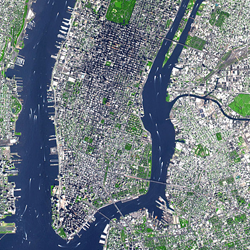
Sandy reminded them by creating storm surges so high that part of the East and Hudson rivers flooded into many of their homes, cars and New York City’s infrastructure, leaving thousands without electricity, food or housing for days. In fact, two weeks later, many are still without these things and it has been predicted that some will remain homeless for quite a while after Sandy rendered their homes uninhabitable.
In the midst of the inevitable post-Sandy discussion, the topic of global climate change has come up once again. This is because some have argued that storms like Sandy are a result of global warming and that, given the current trend in the climate, we can “expect more where Sandy came from”. And, as many readers are no doubt aware, most climate scientists think that the upward trend in average global temperature, over the last 100 years or so, is caused mainly by human activity. Thus, if we humans don’t change our ways, my home in New York City and other low lying areas around the world, might have to contend with the likes and effects of Sandy-type storms for years to come. But what kind of behavioral changes are required?
An article on this topic that appeared on National Geographic’s website offered these suggestions: compost organic waste, recycle other household waste, turn off lights when we leave the room, cycle and walk instead of driving, and similar practices. The article is careful to state that these behavioral changes won’t stop global warming but could significantly reduce CO2 emissions, the main culprit in the global warming story.
Now whenever I consider these kinds of behavioral changes and the likelihood of them occurring on a large enough scale to help address the global warming challenge, I become a bit depressed. This is due to my familiarity with game theory, an area of mathematics studied by both economists and statisticians. One of the scenarios frequently discussed in game theory is the Assurance game. The following table has the set up:

“Cooperate” is a generic term that refers to some kind of pro-social behavior and “Don’t Cooperate” refers to some type of anti-social behavior. “Row” refers to the row player and “Column” to the column player. The “bottom line” of the Assurance game is that if players are rational, meaning they want to maximize payoffs (the numbers in the table) to themselves, there is a good chance that they will both end up not cooperating. That is, there is a good chance that they’ll end up in the bottom right cell of the table. Here is why.
First, note that in the table above and the one below the first number listed in a cell is the row player's payoff, while the second one listed is the column player's payoff. If the row player cooperates and the column player does too, the row player ends up with a payoff of 6 the highest payoff for that player in the table. But if the row player cooperates and the column player doesn’t do so, the row player ends up with a payoff of 1, the lowest payoff in the table. The problem is that the row player doesn’t know what the column player will do.
Thus, the prudent course for the row player might be not to cooperate. But, as can be seen from the table, the column player faces the same situation. Thus, that player might prudently decide not to cooperate too. Yet if they both decide not to cooperate, they end up doing worse off than if they had both cooperated. What appears to be individually rational behavior turns out to be collectively irrational behavior. What does this have to do with climate change? Well consider Table 2 below:

This is the same table as before, in terms of the payoffs. But I’ve changed who those payoffs apply to. “Go greener” refers to walking more, biking more, composting organic waste, etc. “Don’t go greener” refers to refraining from doing these things and behaving as one always has. The way to read the table is to think of each of us as being in the position of person 1.
Now if person 1 goes greener and everyone else does too, person 1 attains their highest payoff. CO2 levels come down and we make more headway against the problem of global climate change. But if person 1 goes greener and no one else does, person 1 receives their lowest payoff. They’ve changed their behavior but because no one else has, CO2 levels don’t decrease by very much. Not only is this the case but person 1 has also incurred the personal cost of going greener. Thus, on the whole, person 1 will have increased the cost to themselves for nothing. Therefore, they may be better off not changing their behavior. If everyone else does the same, CO2 emissions won’t change—a bad outcome. But it won’t be as bad as CO emissions not coming down and having to pay the increased personal cost of going greener. But if we all (or most of us) think this way none (or not enough) of us go greener.
The problem highlighted by the Assurance game is a lack of trust. If person 1 could trust that others will go greener, there would be an incentive for them to do so as well. In the absence of trust, some other mechanism seems required to move enough people to cooperate. This is where government might come in. Governments, of course, have the authority to require people to behave in certain ways and those ways could certainly include requiring more composting and recycling, less driving, etc. Having “big brother” require us to turn the lights off in our homes, though, might be going it bit too far. But climate change and its predicted negative consequences are global problems. Perhaps this means that we need a global government – can anyone say President or Prime Minister Ban Ki-Moon?



